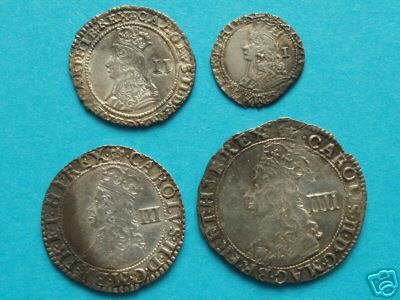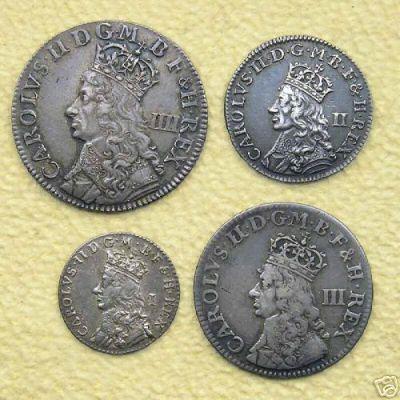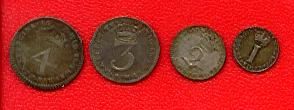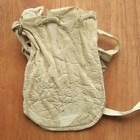The Early Years of Maundy Money.
Probally the first known maundy coin struck was not English but Scottish. It was a groat (4d) of the type of James 1V.There are only two specimens
known of. One of these is held in The British Museum.The other in the National Museum of Antiquities of Scotland.They were first issued in the
maundy service of 1512 held in Scotland.
Maundy money as it is known today started with the undated issue of hammered coinage to King Charles 11 in 1660.These were designed by Thomas Simon
and are referred to as undated maundy money or Simons maundy money.These were first issued on the 9th May 1660.

Charles II Hammered Maundy Set

Undated maundy set. First of milled sets issued in c1664
Silver pennies were given out until 1660 when recipients started to be given mixed coinage of 4d, 3d, 2d and 1d. The earliest official report referring
to the use of mixed coinage was in 1731 in the reign of King George II. That year all four denominations were minted.
The maundy dish used at the ceremony to hold the purses is made of silver gilt. It is circa 2 feet in diameter and weighs approximately 202 oz.
The dish dates back to King Charles II (1660 - 1685). and carries the arms of William & Mary (1688 - 1694). At the ceremony the dish is usually
carried by the monarch who is guarded by Yeomen.

1693 William & Mary Maundy Set
The maundy money gifts to pensioners are said to fulfill Jesus's eve of the crucifiction command to his followers to love one another.
After 1731 complete denominations of 1d to 4d coins were only issued in 16 of the years up to 1799. The penny continued to always be the
favoured denomination at the maundy ceremonies.
It is thought that from 1752 the 1d to 4d coins were minted solely for maundy use. Prior to this ordinary circulating currency coins were used.
The reigning monarch now distributes sets consisting of small silver 4d, 3d, 2d & 1d coins.
The individuals who receive maundy money are given 1d for each year the monarch has been alive.The tradition of linking the number to the monarchs
age started with Henry IV (1399 - 1413).
Until the 18th century maundy money was distributed only to the same sex as the sovereign. Both men and women receive equal amounts these days.
Although the origin of the maundy ceremony is believed to date back to the reign of Edward II (1307 - 1327) it was not until Elizabeth I came to the
throne that money was regularly distributed to the poor. Previously goods were given to the poor by the reigning monarch as described earlier. The
monarchs got fed up with the poor fighting for the clothing and this tradition stopped.
Examples of the clothing and food gifts
1556 A piece of cloth for clothing, stockings, a pair of shoes and the aprons and towels used in the "pendelavium".
Enough food for four people and a bowl of wine.
1633 A fine shirt, three yards of broad cloth and a pair of shoes.
Green fish salmon, red-herring, two loaves of bread and claret wine.
1699 Two yards of broadcloth, four yards of linen cloth, new shoes and stockings.
A salt cod with salmon, two dozen herrings and a bowl of wine.
1731 Shoes, stockings, linen and woolen cloth.
One large old ling, one large dried cod, twelve red herrings and four half quarter loaves.

An early puse which held the maundy coins
Contact Us : maundy@email.com